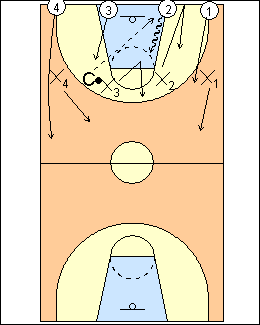4 on 4 recover
 | 1 Four attackers are on the baseline, four defenders are matched up on the foul line extended. Coach passes to any attacker to start the fast break, his defender has to touch the baseline before defending. Play up and back, to 2 baskets, or continuously. Attackers switch to defence, defenders leave, new attackers come on. Variations - on a stop or score, the last player on the attacking team to touch the ball must touch the nearest sideline/baseline corner before defending the counter attack (or the nearest sideline or baseline, or the baseline in his frontcourt) - no cherry picking, all attackers must be in their frontcourt for a shot to count - start with regular 4 on 4 attack - 2, 3, or 5 players per team - defenders are numbered, coach calls one number or two (option - one attacker has a ball). Larry Shyatt - 5 on 5, coach passes to an attacker, calls the name (or number) of one defender or two defenders, who must touch the baseline. Optionally require a sideline break to create a helpside. In transition defence you have a man when somebody yells "ball". See Florida circle the wagons rebounding. Mike MacKay - someone must guard the ball as soon as possible, creating decision-making situations for the attackers. beone.basketball.ca - 3 on 3, to begin the defender in the middle touches the baseline. Seth Miller - coach calls "shot", the two forwards/centers on the defensive team must pause for a 1-count as coach throws the ball to one of the attackers (defenders don't touch the baseline). Lloyd Mitchell (Greenvale) - to ensure that initial pressure forces the ball to the sideline, the defender of the first receiver is pre-determined, depending on where the pass goes. Here on the pass to 2, X1 stays with 1, X3 takes the ball, X4 gets to the splitline and initially covers two players (3 and 4). X3 would also take the ball on a pass to 4, X2 takes the ball on a pass to 1 or 3. Mitchell - Find your man - 5 on 5, defenders match up with attackers then turn their backs to face halfcourt, on "change" attackers can move anywhere on the baseline, coach hands one of them the ball, on "go" they attack the other basket, defenders must turn, run and find their match-up. Repeat at the other basket or go up and back, optionally make-it take-it. Coach can adjust how close defenders are to the baseline. Tony Barone - start with 3 on 3 (two defenders try to get into a tandem), then 4 on 4 and 5 on 5. John Calipari - 5 on 5 transition defence - on each team, the same two defenders have to touch the baseline after each offensive possession, go 4 trips up and back, offence can take an open layup otherwise the ball has to be swung, then it's live. Brian McCormick - 2 on 2, 3 on 3, 4 on 4, and 5 on 5, use a mirror with 5 on 5, on a pass to an outside attacker, defenders of both outside attackers touch the baseline, it's the same on a pass to either player beside the outside players. Herb Brown a) 4 on 4, defenders are not necessarily matched up with their checks, coach passers to any attacker, calls the number (or name) of a defender who has to touch the baseline, the other defenders protect the goal and stop the ball, get back at least level with the ball, if your check has been picked up, find the free attacker closest to the basket, the trail defender recovers and picks up the free attacker, who should be furthest from the ball and the basket. b) 4 on 4, coach passes to any attacker, the defender in front of him must touch the baseline, play to a stop or score (one way), progression - 5 on 5, the defence changes to offence on a score (try to run a play after a made shot, fast break or run early offence after misses or steals). See Fast break - Dean Smith secondary break, Transition - 5 on 5 defensive transition. |
This page was made with Basketball playbook from Jes-Soft